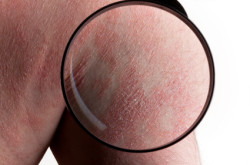Top Class Actions’s website and social media posts use affiliate links. If you make a purchase using such links, we may receive a commission, but it will not result in any additional charges to you. Please review our Affiliate Link Disclosure for more information.
Two boys from Tampa Bay, Fla., ages 6 and 16, contracted the painful and often deadly skin condition known as Stevens Johnson Syndrome. SJS is a drug-induced skin reaction that can occur after taking any number of prescription and over-the-counter medications, though some drug families like quinolone drugs have a higher SJS risk rate than others.
According to news reports, 6-year-old Kyan N. contracted SJS in December of last year. He was admitted into a hospital burn unit, and shortly after his initial hospitalization Kyan was diagnosed with Stevens Johnson Syndrome. The disease was slowly burning his body from the inside out. After developing an SJS rash, Kyan also experienced blisters forming over his body, which later caused the top layer of skin to fall off. Kyan is now recovering from his bout with SJS.
Only a few weeks prior to Kyan’s SJS hospitalization, 16-year-old Sean B., also of Tampa Bay, was admitted to the hospital for his SJS condition. Stevens Johnson Syndrome burns the top layer of skin, leaving it open to infection. Sean contracted a deadly infection, MRSA, while in the hospital and died on Jan. 1, 2015. This is an all too common story for SJS victims. While many SJS patients recover, some die due to trauma or because of secondary infections that the weakened body can not as easily fight off due to the allergic skin condition.
While the news reports do not mention what medication either boy was using at the time they contracted Stevens Johnson Syndrome, it is possible that either one or both were using the quinolone antibiotic Avelox, as this drug and the quinolone drug family in general have a high rate of SJS incidences.
Quinolones (also known as fluoroquinolones) are a group of antibiotics sold under a host of brand names including Cipro, Levaquin, and Avelox, as well as various generic drug names.
While there are many benefits from taking quinolone antibiotics like Avelox, as they are fast acting and efficient in taking care of bacterial infections, there are also serious and sometime life-threatening quinolone side effects like Quinolone Stevens Johnson Syndrome.
Stevens Johnson Syndrome
Stevens Johnson Syndrome (SJS) and Toxic Epidermal Necrolysis (TEN) are painful, and on occasion fatal, skin conditions. An individual may develop SJS or TEN as an allergic reaction to various prescription and over-the-counter medications. However, quinolone antibiotic drugs like Avelox have been found to have a high number of reported cases of serious SJS and/or TEN quinolone reactions.
SJS and TEN are the same drug-induced skin disease, although SJS is a milder form, covering 10 to 30 percent of a patient’s body surface area. TEN, the more aggressive and often deadlier form, burns and blisters cover more than 30 percent of an SJS victim’s body.
Both SJS and TEN are rare, with only a few hundred cases occuring every year in the United States. However, they can be deadly, as those patients who contract TEN have a 30 to 50 percent chance of dying.
Almost all known SJS and TEN cases are set off by drugs, including Avelox, other quinolone antibiotics, NSAIDs, anti-epileptic drugs, penicillin, and sulfa drugs, among others.
Patients with SJS usually first experience flu-like symptoms that are quickly followed by blisters forming on the skin and the mucous membranes in the mouth and eyes. These blisters eventually lead to the skin sloughing off from the victim’s body, leaving SJS burns, and increase a patient’s risk of infection. So far, no one medical treatment has proven to be more beneficial than another when treating SJS or TEN. However, common SJS treatments include steroids, immune suppressants such as immunoglobulin treatments, and plasma exchanges.
Even after surviving SJS and TEN, patients may still deal with permanent scarring, lung, and eye damage.
As a result of the pain and suffering experienced by quinolone SJS victims, many users of Avelox and other quinolone antibiotics or their family members have filed quinolone SJS lawsuits or have joined quinolone SJS class action lawsuits.
Do YOU have a legal claim? Fill out the form on this page now for a free, immediate, and confidential case evaluation. The attorneys who work with Top Class Actions will contact you if you qualify to let you know if an individual lawsuit or class action lawsuit is best for you. [In general, quinolone lawsuits are filed individually by each plaintiff and are not class actions.] Hurry — statutes of limitations may apply.
ATTORNEY ADVERTISING
Top Class Actions is a Proud Member of the American Bar Association
LEGAL INFORMATION IS NOT LEGAL ADVICE
Top Class Actions Legal Statement
©2008 – 2024 Top Class Actions® LLC
Various Trademarks held by their respective owners
This website is not intended for viewing or usage by European Union citizens.
Get Help – It’s Free
Join a Free Quinolone Class Action Lawsuit Investigation
If you or someone you know took Cipro, Levaquin, Avelox or another quinolone antibiotic and were diagnosed with liver failure, Stevens Johnson Syndrome (SJS) or toxic epidermal necrolysis (TEN), you may have a legal claim. See if you qualify by submitting your information below for a free and confidential case review.
An attorney will contact you if you qualify to discuss the details of your potential case at no charge to you.
Oops! We could not locate your form.













